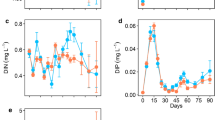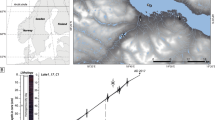Abstract
Temperature-driven changes in interactions between populations are crucial to the estimation of the impact of global warming on aquatic food webs. We analysed inter-annual variability in two data sets from Bautzen reservoir, Germany. In a long-term data set (1981–1999) we examined the pelagic phenology of Daphnia galeata, a keystone species, the invertebrate predator Leptodora kindtii, phytoplankton and Secchi depth in relation to water temperature and the North Atlantic Oscillation index. In a short-term data set (1995–1998) we examined food web relations, particularly the consumption of D. galeata by young-of-the-year (YOY) percids and L. kindtii and rates of population change of D. galeata (abundance, recruitment pattern and non-consumptive mortality). The start of the clear-water stage (CWS) was correlated with winter temperatures. It started 5.8 days earlier per degree warming after warm winters (mean January–March temperature ≥2.5°C) compared to cold winters (mean temperature <2.5°C). However, the end of the CWS remained relatively constant. Predation by L. kindtii and YOY percids on D. galeata started distinctly earlier, i.e. by 13.0 and 6.5 days per degree warming, respectively, in years when the average May temperature was high (≥14°C) compared to years when it was low (<14°C). Significant reductions of Daphnia abundance in midsummer occurred only in years in which the mean May temperature exceeded 14°C. This temperature regime resulted in a match of over-exploitation of food resources by Daphnia during the CWS and strong predation by YOY percids and L. kindtii. Consumptive mortality increased at higher rates with a rise in temperature than net recruitment, resulting in lower Daphnia densities at the end of the CWS. Our data suggest that even low warming by 1.7°C during a short, but critical seasonal period, resulting in the coincidence of two or more factors adversely affecting a keystone species, such as Daphnia, may induce changes in whole lake food webs and thus alter entire ecosystems.






Similar content being viewed by others
References
Adrian R, Deneke R, Mischke U, Stellmacher R, Lederer P (1995) A long-term study of the Heiligensee (1975–1992): evidence for effects of climatic change on the dynamics of eutrophied lake ecosystems. Arch Hydrobiol 133:315-337
Beisner BE, McCauley E, Wrona FJ (1997) The influence of temperature and food chain length on plankton predator-prey dynamics. Can J Fish Aquat Sci 54:586–595
Benndorf J, Schultz H (2000) Talsperre Bautzen: Langzeit-Biomanipulation bei sehr hoher Nährstoffbelastung. In: Willmitzer H (ed) Fischerei und fischereiliches Management an Trinkwassertalsperren. ATT Tech Inf 11:73–79
Benndorf J, Kranich J, Mehner T, Wagner A (2001) Temperature impact on the midsummer decline of Daphnia galeata a long-term data analysis from the biomanipulated Bautzen reservoir (Germany). Freshwater Biol 46:199–212
Boersma M, van Tongeren OFR, Mooij WM (1996) Seasonal patterns in the mortality of Daphnia species in a shallow lake. Can J Fish Aquat Sci 53:18–28
Böing WJ, Wagner A, Voigt H, Deppe T, Benndorf J (1998) Phytoplankton responses to grazing by Daphnia galeata in the biomanipulated Bautzen reservoir. Hydrobiologia 389:101–114
Delos Reyes MR, Arzbach HH, Braum E (1992) In situ development of perch eggs Perca fluviatilis L. (Pisces Percidae) in a small eutrophic lake Lake Plusssee Holstein Germany. Int Rev Ges Hydrobiol 77:467–481
DeStasio BT, Hill DK, Kleinhans JM, Nibbelink NP, Magnuson JJ (1996) Potential effects of global climate change on small north-temperate lakes: physics, fish and plankton. Limnol Oceanogr 41:1136–1149
Dörner H, Wagner A, Benndorf J (1999) Predation by piscivorous fish on age-0 fish: spatial and temporal variability in a biomanipulated lake (Bautzen reservoir, Germany). Hydrobiologia 408/409:39–46
Eckmann R, Gaedke U, Wetzlar HJ (1988) Effects of climatic and density-dependent factors on year-class strength of Coregonus lavaretus L. in Lake Constance. Can J Fish Aquat Sci 45:1088–1093
Edwards M, Richardson AJ (2004) Impact of climate change on marine pelagic phenology and trophic mismatch. Nature 430:881–884
Emmerson M, Bezemer M, Hunter MD, Jones TH (2005) Global change alters the stability of food webs. Glob Change Biol 11:490–501
George DG, Hewitt DP (1999) The influence of year-to-year variations in winter weather on the dynamics of Daphnia and Eudiaptomus in Esthwaite Water, Cumbria. Funct Ecol 13:45–54
George DG, Hewitt DP (2006) The impact of year-to-year changes in the weather on the dynamics of Daphnia in a thermally stratified lake. Aquat Ecol 40:33–47
George DG, Hewitt DP, Lund JWG, Smyly WJP (1990) The relative effects of enrichment and climate change on the long-term dynamics of Daphnia in Esthwaite Water, Cumbria. Freshwater Biol 23:55–70
George DG, Talling JF, Rigg E (2000) Factors influencing the temporal coherence of five lakes in the English Lake District. Freshwater Biol 43:449–461
Gerten D, Adrian R (2001) Differences in the persistency of the North Atlantic Oscillation signal among lakes. Limnol Oceanogr 46:448–455
Hall DJ (1964) An experimental approach to the dynamics of a natural population of Daphnia galeata Mendotae. Ecology 45:94–112
Hanson PC, Johnson TB, Schindler DE, Kitchell JF (1997) Fish bioenergetics 30. WISCU-T-97–001. University of Wisconsin Sea Grant Institute, Center for Limnology, Wis.
Herzig A (1995) Leptodora kindtii—efficient predator and preferred prey item in Neusiedler See (Austria). Hydrobiologia 307:273–282
Hülsmann S (2003) Recruitment patterns of Daphnia a key for understanding midsummer declines? Hydrobiologia 491:35–46
Hülsmann S, Weiler W (2000) Adult not juvenile mortality as a major reason for the midsummer decline of a Daphnia population. J Plankton Res 22:151–168
Hülsmann S, Voigt H (2002) Life-history of Daphnia galeata in Bautzen reservoir (Germany) during spring and early summer and consequences of non-consumptive mortality for the initiation of a midsummer decline. Freshwater Biol 47:2313–2324
Johnsen G (1983) Egg age distribution the direct way to cladoceran birth rates. Oecologia 60:234–236
Lampert W, Fleckner H, Rai H, Taylor BE (1986) Phytoplankton control by grazing zooplankton: a study on the spring clear-water phase. Limnol Oceanogr 31:478–490
Mehner T (2000) Influence of spring warming on the predation rate of underyearling fish on Daphnia—a deterministic simulation approach. Freshwater Biol 45:253–263
Mehner T, Schultz H, Bauer D, Herbst R, Voigt H, Benndorf J (1996) Intraguild predation and cannibalism in age-0 perch (Perca fluviatilis) and age-0 zander (Stizostedion lucioperca): interactions with zooplankton succession prey fish availability and temperature. Ann Zool Fenn 33:353–361
Mehner T, Hülsmann S, Worischka S, Plewa M, Benndorf J (1998a) Is the midsummer decline of Daphnia really induced by age-0 fish predation? Comparison of fish consumption and Daphnia mortality and life history parameters in a biomanipulated reservoir. J Plankton Res 20:1797–1811
Mehner T, Plewa M, Hülsmann S, Worischka S (1998b) Gape-size dependent feeding of age-0 perch (Perca fluviatilis) and age-0 zander (Stizostedion lucioperca) on Daphnia galeata. Arch Hydrobiol 142:191–207
Migaud H, Mandiki R, Gardeur JN, Kestemont P, Bromage N, Fontaine P (2003) Influence of photoperiod regimes on the Eurasian perch gonadogenesis and spawning. Fish Physiol Biochem 28:395–397
Mooij WM, Lammens EHRR, Densen WLT (1994) Growth rate of 0+ fish in relation to temperature, body size, and food in shallow eutrophic Lake Tjeukemeer. Can J Fish Aquat Sci 51:516–526
Mooij WM, Hülsmann S, De Senerpont Domis LN, Nolet BA, Bodelier PLE, Boers PCM, Dionisio Pires ML, Gons HJ, Ibelings BW, Noordhuis R, Portielje R, Wolfstein K, Lammens EHRR (2005) The impact of climate change on lakes in the Netherlands: a review. Aquat Ecol 39:381–400
Moore MV, Folt CL, Stemberger RS (1996) Consequences of elevated temperatures for zooplankton assemblages in temperate lakes. Arch Hydrobiol 135:289–319
Müller-Navarra DC, Güss S, von Storch H (1997) Interannual variability of seasonal succession events in a temperate lake and its relation to temperature variability. Global Change Biol 3:429–438
Petchey OL, McPhearson T, Casey TM, Morin PJ (1999) Environmental warming alters food-web structure and ecosystem function. Nature 402:69–72
Post DM, Kitchell JF (1997) Trophic ontogeny and life history effects on interactions between age-0 fishes and zooplankton. Arch Hydrobiol Spec Issues Adv Limnol 49:1–12
Reynolds CS (1984) The ecology of freshwater phytoplankton. Cambridge University Press, Cambridge
Rinke K, Vijverberg J (2005) A model approach to evaluate the effect of temperature and food concentration on individual life history and population dynamics of Daphnia. Ecol Model 186:326–344
Sommer U, Gliwicz ZM, Lampert W, Duncan A (1986) The PEG-model of seasonal succession of planktonic events in fresh waters. Arch Hydrobiol 106:433–471
Straile D (2000) Meteorological forcing of plankton dynamics in a large and deep continental European lake. Oecologia 122:44–50
Straile D, Adrian R (2000) The North Atlantic Oscillation and plankton dynamics in two European lakes—two variations on a general theme. Global Change Biol 6:663–670
Straile D, Livingstone DM, Weyhenmeyer GA, George DG (2003) The response of freshwater ecosystems to climate variability associated with the North Atlantic Oscillation. In: Hurrell JW, Kushnir Y, Ottersen G, Visbeck M (eds) The North Atlantic Oscillation—climatic significance and environmental impact. AGU Geophysical monograph series. AGU, pp 263–279
Strecker AL, Cobb TP, Vinebrooke RD (2004) Effects of experimental greenhouse warming on phytoplankton and zooplankton communities in fishless alpine ponds. Limnol Oceanogr 49:1182–1190
Talling JF (2003) Phytoplankton-zooplankton seasonal timing and clear-water phase in some English lakes. Freshwater Biol 48:39–52
Threlkeld ST (1979) The midsummer dynamics of two Daphnia species in Wintergreen Lake Michigan. Ecology 60:165–179
Uusitalo L, Horppila J, Eloranta P, Liljendahl-Nurminen A, Malinen T, Salonen M, Vinni M (2003) Leptodora kindti and flexible foraging behaviour of fish factors behind the delayed biomass peak of cladocerans in Lake Hiidenvesi. Int Rev Hydrobiol 88:34–48
Vandekerkhove J, Declerck S, Rendonck L, Conde-Porcuna JM, Jeppesen E, DeMeester L (2005) Hatching of cladocerans resting eggs: temperature and photoperiod. Freshwater Biol 50:96–104
Vijverberg J, Koelewijn HP (2004) Effect of temperature on development and growth of the raptorial cladoceran Leptodora kindtii under laboratory conditions. Freshwater Biol 49:1415–1422
Wagner A, Hülsmann S, Dörner H, Janssen M, Kahl U, Mehner T, Benndorf J (2004) Initiation of the midsummer decline of Daphnia as related to predation non-consumptive mortality and recruitment: a balance. Arch Hydrobiol 160:1–23
Wagner A, Hülsmann S, Bollenbach M, Benndorf J (2005) Prey or predator: piscivory as a factor controlling the role of invertebrate predators (Leptodora kindtii, Chaoborus flavicans, Piona spp.) in a biomanipulated reservoir. Verh Int Verein Limnol 29:993–996
Weyhenmeyer GA, Adrian R, Gaedke U, Livingstone DN, Maberly SC (2002) Response of phytoplankton in European lakes to a change in the North Atlantic Oscillation. Verh Int Verein Limnol 28:1436–1439
Winder M, Schindler DE (2004) Climatic effects on the phenology of lake processes. Global Change Biol 10:1844–1856
Worischka S, Mehner T (1998) Comparison of field-based and indirect estimates of daily food consumption in larval perch and zander. J Fish Biol 53:1050–1059
Acknowledgements
We thank T. Mehner for initiating the YOY fish project. We are also grateful to S. Worischka, M. Plewa, M. Janssen and T. Mehner for providing additional data on YOY fish and S. Hülsmann and H. Voigt for providing their data of D. galeata abundance, recruitment and mortality. The long-term study was facilitated by the zooplankton analyses of E. Penz, H. Kneschke, K. Kossatz, U. Hornig, R. Dumke, R. Kruspe, S. Reichel, A. Köhler, U. Miersch, B. Meltzer, A. Herschel, P. Ritter, R. Zehrer, H. Voigt, J. Kranich and M. Bollenbach. We thank G. Egerer for technical support. Furthermore, we thank A. Dettinger-Klemm, F. Wilhelm, R. Zehrer, S. Hülsmann and two anonymous reviewers for valuable comments on the manuscript. The study was financed by the Federal Ministry of Education and Research (BMBF), Germany (grant nos. 0339423A and 0339549) and by the German Research Council (DFG; project numbers Be 1671/2-1, 2-2 and 2-3). We declare that the experiments in this study comply with the current laws of Germany.
Author information
Authors and Affiliations
Corresponding author
Additional information
Communicated by Ulrich Sommer.
Priority programme of the German Research Foundation—contribution 9.
Rights and permissions
About this article
Cite this article
Wagner, A., Benndorf, J. Climate-driven warming during spring destabilises a Daphnia population: a mechanistic food web approach. Oecologia 151, 351–364 (2007). https://doi.org/10.1007/s00442-006-0554-5
Received:
Accepted:
Published:
Issue Date:
DOI: https://doi.org/10.1007/s00442-006-0554-5




